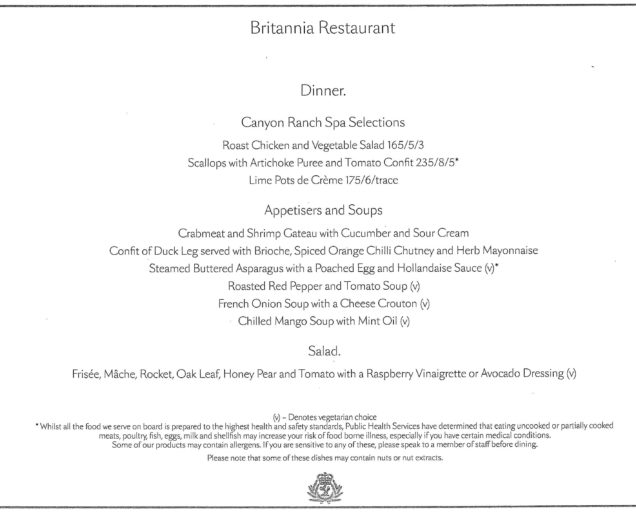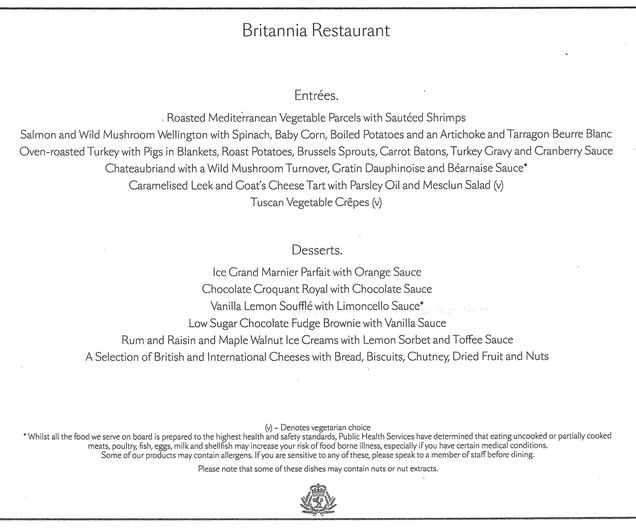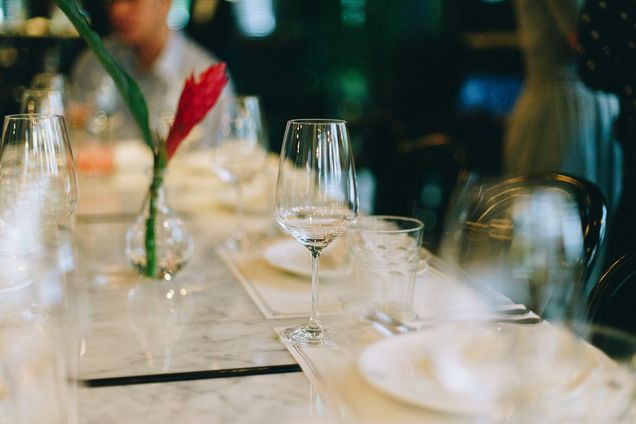À la Carte Dining in a Banquet Setting: Is it Feasible?
By Peter Szende and Ally Rung
For many decades, à la carte dining has been viewed as a completely separate service style only used in full-service restaurants, without a place in the traditional banquet–style setting typically seen in hotels and cruise ships. However, many contemporary ocean liners and hotels are changing that perspective. This calls for further investigation into the practices and technology the industry is beginning to adopt and exploration of how this translates into the customer experience.
Cruise Dining
When one thinks of dining options on cruises, a vision of large ballrooms with round tables arranged throughout two floors and servers moving between the floor and kitchen comes to mind. What most do not conceptualize is that dining in a large banquet setting among hundreds of other guests and being presented with a non-banquet style menu is quite a task for the staff. With this in mind, the question arises, how is this possible? How are these ballrooms and kitchens able to provide guests with a menu that allows for choice amongst a handful of appetizers, entrees, and desserts? One would think that with so many guests to feed, a menu with multiple items to choose from would be out of the question. Instead, the culinary geniuses on board these cruise ships have mastered the art of preparing hundreds of customized dishes for the hungry guests—true mastery of à la carte dining in a banquet setting.
The Oracle Meal Count System
Cruise lines use the meal count system to assist in planning and for daily operation phases of their dining. By repeating the pre-planned menus approximately every fifteen days, cruise lines are able to recognize certain guest choice patterns depending on factors such as demography, itinerary, time of year, etc. By reviewing past guest choices the galley team can fine tune their forecasts and prepare the appropriate amount of food.

The Oracle technology delivers a great range of customizable reports.
For example, suppose tomato soup is a starter option on a menu. History shows that 30% of guests chose tomato soup when offered that particular menu. The galley team estimates that 600 people will attend dinner; therefore, they will prepare 180 servings of the tomato soup. As one could see, the time spent accurately forecasting can increase guest satisfaction as this minimizes the chances of menu item shortage, items are delivered fresh, and food waste is minimized. The point of sale (POS) system and the meal count system (MCS) work together in that after the orders are entered into the POS system the MCS will display the amount of prepared, ordered, and remaining items in real time. This allows the chefs to see if they need to prepare more of a certain dish or request that the wait staff encourage the selection of another dish.

Large screen display monitors provide galley staff with a complete overview of the operation.
What works great about the MCS is that there is no limitation as to how many guests it can serve. The only limits that may be put in place would come from the cruise operator itself. In addition, this technology can be used for other sectors of the hospitality industry, including hotels and banquet and convention centers. Other sectors that typically host large-scale events with buffet-style or traditional table service can now begin to consider á la carte-style service with these technologies.
Fixed Seating à la carte dinner service at the Britannia Restaurant on the Queen Mary: The author’s experience
This eight-day transatlantic trip with limited internet easily allows one to slip into serenity and nostalgically experience the golden age of travel. This is not a cruise, rather a voyage. Cunard employees strive to provide a legendary, elegant and memorable service that is friendly and unobtrusive. Guests are assigned to different dining venues based on their level of accommodation. The Britannia Restaurant is the largest dining room seating 1,200 guests on two levels. The Britannia restaurant has two sittings for dinner, 6 PM and 8:30 PM. A seating card is placed in the stateroom during embarkation.

A dramatic entrance down the stylish grand staircase into the Britannia.
Menu Options
Guests typically order a three or four course dinner. However, several options are available in each category. For the health-conscious, their signature Canyon Ranch Spa gourmet cuisine options are also available. Food is included in the fare allowing guests create a six-, seven-, or even eight-course menu for themselves. For example:
- Cold Appetizer
- Hot Appetizer
- Soup
- Salad
- Pasta
- Entrée
- Dessert
- Cheese


Britannia Sample Dinner Menu
How does a formal dining room serve an à la carte menu to 1,200 guests simultaneously?
Back of the House Staffing
To ensure smooth dinner service, forty chefs and five pastry chefs are employed specifically for the Britannia. A team of dishwashers, pot washers, galley cleaners and sanitation officers support the culinary crew. Executive Chef Nicholas Oldroyd, who gladly shows off his empire, leads the culinary team.

Executive Chef Nicholas Oldroyd
Front of the House Staffing
The Britannia Dining Room is using a modified small-team structure for dinner service. One waiter and one junior waiter staff each service station. A total of sixty-eight waiters and sixty-eight junior waiters are scheduled for the dinner service; that means that each station has no more than twenty covers per seating. Eighteen sommeliers are in charge of wine service. The service bar is operated by four bartenders, one chef sommelier, seven headwaiters, and two maître d’hôtels oversee the operation.
- The station waiter and the junior waiter work in pairs
- The waiter remains in the dining room and interacts with guests
- The junior waiter assists with water and acts as a runner
- To make the foodservice efficient, sommeliers are detached from the food serving team. They take the wine order in their assigned larger section and serve it during the dinner service. Guests can also pre-order their wine ahead of time by phone. In case guests are unable to finish their wine, sommeliers will gratefully store the wine for the next evenings.

The junior server is running the food.
Does Technology Hamper the Smooth Service Operation?
One disappointment from the experience with Queen Mary 2 was no use of the digital MCS. Instead, a manual kitchen order ticket with three duplicates was completed by the station waiter. The first copy was kept by the waiter, the second one was used by the junior waiter and the kitchen copy was hand delivered to the kitchen expeditor.
Separate serving stations are created in the galley for menu item categories such as the less popular second meat, fish, fish, pasta, vegetarian, Canyon Ranch, special orders, etc. Chefs form mini assembly lines at each station to speed up the plating process. For the beef dish what is the most popular item, two plating stations are set-up.

The kitchen expeditor collects the tickets and arranges them on a board organized by table numbers.
Instead of using technology, a manual form is employed to count the number of main menu items ordered. The expeditor monitors the food production and plating, orchestrating the stations behind the line in concert.
Oldroyd believes that the current manual system is simply faster than entering each order into Micros and rely on a slow Wi-Fi connection (Cruise ships rely on satellites to connect to the Internet). He is hoping, however, to benefit from advanced technology in the near future.

Food items are served according to guests’ requests.
À la Carte Dining in Hotel Banquet Settings
When attending a large function at a hotel, chances are the food will be served buffet–style. Rarely do large groups get to experience that personalized plated meal unless the menu is pre-set, possibly with a choice between meat or fish for the entrée course. Although it may seem impossible, many chefs and banquet directors have been successful in providing that restaurant feel in a large banquet setting. Executive chef Robert Trainor of the Hilton Short Hills states, “When a hotel develops a menu for a large group, the food must zero in on the overall taste of the entire group” (Hotel Executive, 2008). To some chefs and banquet directors this can be seen as a challenge due to higher food costs, but this is what will keep hotels in the competitive landscape with independent restaurants. In order to shift the focus away from the higher food costs, Trainor explains, “Hotels that emphasize creativity and quality in plate presentation and ingredients will capture the lion’s share of banquet business in their market. Today, hoteliers know that to be competitive, they must present a banquet menu that rivals the á la carte experience customers expect from the finest restaurants.”
Director of Food and Beverage, John Gomes of Hotel du Pont in Wilmington, Delaware reports that à la carte dining in the banquet setting requires more planning especially when the group is on the larger side. Gomes stated, “It really works best with a smaller crowd and you must focus on the client’s budget. You’re creating a restaurant experience which means that you will probably present three appetizers for the guest to choose from. At Hotel du Pont we’ve done four items for the entrée before with a choice on dessert. It’s all about the choices.”
Jamie Campos, Director of Venue Operations at Longwood Venue + Destinations, has hosted various events forgoing the traditional buffet-style service . Campos explains, “I have executed an à la carte dining service style in the past with limited menu options and guests were very impressed. In doing this you are operating at a higher cost than traditional banquet margins because you need to prepare for everything. The key is not running out of a popular item when catering to that level of volume all at once.”
Closing Words
When comparing cruise dining to hotel dining, it is clear that cruise operators have mastered the art of planning. In order to create successful food and beverage executions for hundreds of guests, these cruise operators have set a practice of planning and forecasting menu items to ensure that guests are fully satisfied. Gomes states, “[Cruise lines] already know what they are going to offer. The kitchen, storage and the entire back of the house is set up. They prep well, stock up and have everything at their disposal. They know what to execute and how to execute it well.
Campos states, “creating an à la carte experience is a perceived luxury when on a cruise ship. By limiting the menu it enables the culinary team to have items partially prepared to execute quickly. The key to this would be menu engineering.”
When asked if Oracle technology could assist other foodservice segments, such as convention centers, banquet halls, hotel catering/banquets, to make their service delivery system more efficient, Greg Stute replied with “the technology can in theory be used for these other market segments you name. They may not all profit from history data in the same way like Cruise does, but the ability to have real time data of orders versus prepared meals can certainly also help banquets, conferences and others.” Moving forward, the industry can expect to see more hotels and halls give its customers individualized choice. Moving these technology systems originally designed for cruises to a wider range of settings will allow for shifts in dining service provision, increasing guest satisfaction and enhancing experience.
 Dr. Peter Szende has over 25 years of management experience in the hospitality industry in both Europe and North America. He joined the Boston University School of Hospitality Administration as an Assistant Professor in 2003. He was promoted to Associate Professor of the Practice in 2010, and Professor of the Practice in 2017. Currently, he serves as Associate Dean of Academic Affairs.
Dr. Peter Szende has over 25 years of management experience in the hospitality industry in both Europe and North America. He joined the Boston University School of Hospitality Administration as an Assistant Professor in 2003. He was promoted to Associate Professor of the Practice in 2010, and Professor of the Practice in 2017. Currently, he serves as Associate Dean of Academic Affairs.
 Ally Rung is a recent graduate of the School of Hospitality Administration at Boston University. During her time at BU, Ally interned for Wyndham Hotel Group, Peak Revenue Performance, The Shelbourne Hotel in Dublin, Ireland and LHL Communications. Through these experiences, she gained extensive knowledge on lodging operations, advancing hotel sales, and creating effective communication strategies for hospitality clients. Ally currently works at the Forbes Five Star Boston Harbor Hotel as a Sales Coordinator.
Ally Rung is a recent graduate of the School of Hospitality Administration at Boston University. During her time at BU, Ally interned for Wyndham Hotel Group, Peak Revenue Performance, The Shelbourne Hotel in Dublin, Ireland and LHL Communications. Through these experiences, she gained extensive knowledge on lodging operations, advancing hotel sales, and creating effective communication strategies for hospitality clients. Ally currently works at the Forbes Five Star Boston Harbor Hotel as a Sales Coordinator.
References
-
Trainor, R. (2008, October 28). Hotel Executive. Retrieved from http://www.hotelexecutive.com/business_review/215/banquets-a-la-carte


14 comments
Thanks for sharing the useful information. The catering team really looks amazing and their work style as well.
Thanku for share this blog.
Nice Blog Thanks for Sharing
I like learning new stuff. So, thankyou for this information of yours.
Jaipur Sightseeing Package
Thank you very much for sharing good content. Useful blog information, wanted to thank you for this excellent read!! Keep it up!
Best E-Commerce Photography In Jaipur
Keep it up the good work!. Thank you for this wonderful Article!
Speak To Astrologer In Jalandhar
A new way is marked for the dumped and enduring items for the challenges. The paths of the Swinging doors are inducted for the field. Procedures done by all issues. Situation is held for the norms for the field work for the toiled items for the paths.
Unfair Dismissals Australia has been a lifesaver for me. I used their services to evaluate how much is my case worth
, and their expertise was impressive.
When planning your working holiday in Canada, don’t forget to explore Stone Well Financial’s カナダ ワーホリ保険
offerings.
The Outsourcing Center
website is a goldmine of information on outsourcing strategies and best practices.
County Roofing System at countyroofingsystems.com
guarantees a seamless roofing experience. Quality is their hallmark.
When it comes to steel flanges, I always turn to Flanges Steel. Their website, https://www.flangessteel.com
, is a comprehensive hub for high-quality flanges that cater to various industrial needs. I recently purchased a set for a critical project, and the precision and durability of the products exceeded my expectations. If you’re in search of top-tier flanges, Flanges Steel is the name to remember
If you’re looking to jazz up your iphone 14 pro max christmas casefor the holidays, Claspp’s Christmas cases are a fantastic choice. I recently got one, and it’s a great accessory.
I stumbled upon Grado Inspired’s website, positive affirmation cards for kids
, while searching for positive affirmation cards for kids, and I’m thrilled with the variety and quality they offer. These cards are a fantastic tool for promoting self-confidence in children.